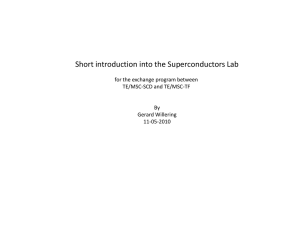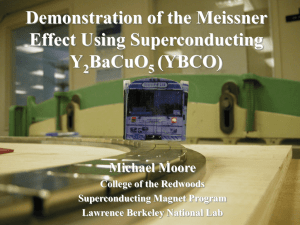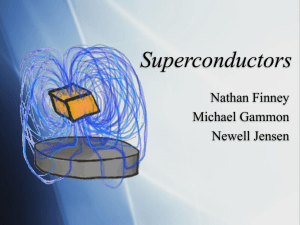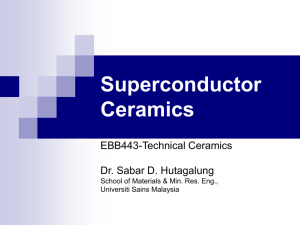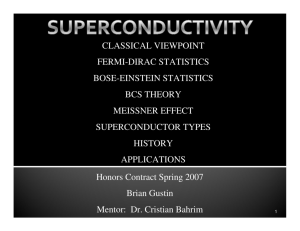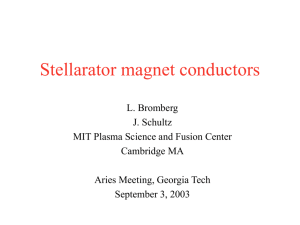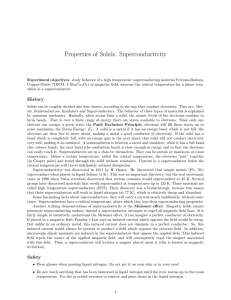PSFC/JA-99-13 L. Bromberg and M. Tekula* May 1999 Plasma Science and Fusion Center
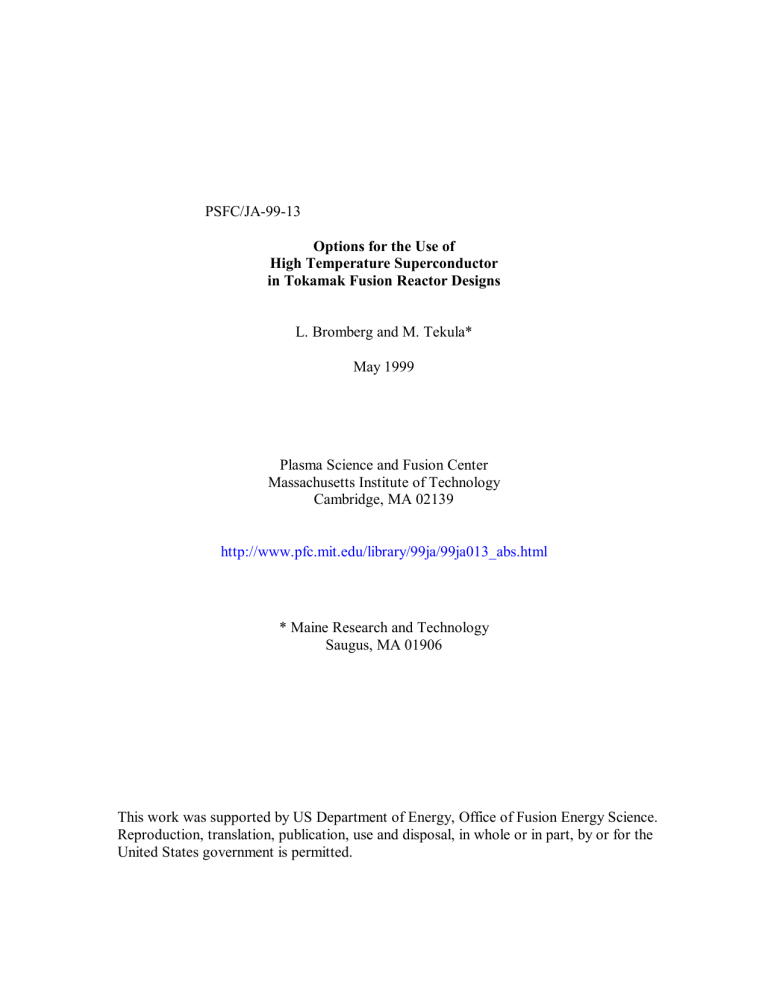
PSFC/JA-99-13
Options for the Use of
High Temperature Superconductor in Tokamak Fusion Reactor Designs
L. Bromberg and M. Tekula*
May 1999
Plasma Science and Fusion Center
Massachusetts Institute of Technology
Cambridge, MA 02139 http://www.pfc.mit.edu/library/99ja/99ja013_abs.html
* Maine Research and Technology
Saugus, MA 01906
This work was supported by US Department of Energy, Office of Fusion Energy Science.
Reproduction, translation, publication, use and disposal, in whole or in part, by or for the
United States government is permitted.
Abstract
The application of high temperature superconductors in long term tokamak fusion reactors is analyzed in this paper. Properties of high temperature superconductors have been well documented that make them ideal for this application. Short-sample BSSCO wires and YBCO tapes approach their single-crystal performance limits. This provides a useful reference frame as well as a starting point of what may be possible in the future.
In this paper, the design issues involved in the use of this technology for tokamak magnet applications will be investigated by extrapolating the properties of short sample YBCO thick films to longer lengths. The properties of YBCO operating at elevated temperatures
(> 10 K) are also summarized. The limitations imposed on the performance and lifetime of the HTS materials because of the fusion environment are reviewed. The consequences of implementing the HTS design requirements in a fusion environment are then described. The HTS material may offer an opportunity for a fundamentally different magnet approach leading to either a lower cost or reduced maintenance. High field toroidal magnets with decreased shielding and with better access and easier maintenance may be feasible.
2
I.
Introduction
High temperature superconducting (HTS) materials are ceramic and therefore brittle in nature. The production of long lengths of wires or tapes suitable for winding magnets has limited the application of high-temperature superconductors. The solutions used in manufacturing high performance A-15 superconductors (such as Nb
3
Sn) are being pursued in the fabrication of HTS wires. Using this approach, filamentary wires (of
BSSCO materials) and thin tapes (of YBCO compounds) have been manufactured with properties that approach ideal limit (highly textured or nearly single crystal).
BSCCO 2212 shows good intergrain current transfer even though the intragrain current density is substantially smaller than that for the YBCO compound and for BSCCO 2223.
Although the properties of BSSCO (2212 and 2223 compounds) are exceptional when compared to low temperature superconductors, the properties of YBCO are even better.
Indeed, if the magnetic field direction is nearly parallel to the YBCO tapes (the ab plane of YBCO is parallel to the tape), then the current density of YBCO at high fields (> 10T) and at 77 K approaches that of Nb
3
Sn at 4 K and 0 T.
BSSCO wires also require a large silver fraction, increasing the cost of the wires and decreasing the engineering current density. Unless higher critical currents can be obtained from the wires, the cost of the silver could prevent their implementation in tokamak reactors.
The non-superconducting fraction of material can be made substantially smaller for
YBCO than for BSSCO, depending on the thickness of the substrate. However, the thickness of superconducting YBCO films that can presently be deposited are very small, on the order of 1
µ m.
In this paper, the options of using YBCO materials for the design of tokamak magnets for long-term fusion reactors will be investigated.
The transient behavior of high Tc materials differs from that of A-15 superconductors.
This is due to the much higher thermal capacity of the materials, which increases as the cube of the temperature for low temperatures. At 20 K, metals and compounds have 2 orders of magnitude larger thermal capacity than at 4 K. This is comparable to the thermal capacity of liquid helium at 4 K. The absence of flux jumping in HTS was investigated using bulk materials (without normal conducting shunts). Instead of flux jumping, the HTS superconductor reaches a critical state, without flux pinning, and the field moves in and out of the superconductor without quench. These tests were performed at the Francis Bitter National Magnet Laboratory at MIT by L. Bromberg and coworkers.
These results have not yet been published.
Flux jumping phenomena for many years slowed down the application of low temperature superconductors. To solve this problem, the LTS conductors were manufactured as thin filaments in a metallic matrix. Flux jumping does not occur with
3
HTS materials operating at elevated temperature. Other constraints, such as brittle fracture and other manufacturability issues, may still require that practical BSSCO conductors be manufactured as thin filaments in a silver composite, and YBCO tapes as thick films.
The effects of replacing low Tc material with high Tc material, without a full understanding of the properties of the high Tc materials was studied in the past [Ehst,
Cohn] Recently a study that provided a roadmap for the implementation of high temperature superconductors in fusion was published [Schultz]. The purpose of the present investigation is not to see how high temperature superconductors need to be introduced into the fusion program, but rather what the options are for ultimately use
HTS in tokamaks.
In this paper, the design restrictions imposed on YBCO tapes used for tokamak fusion reactor magnets operating at elevated temperatures are discussed. The properties and behavior of YBCO are described. Design options using HTS conductors in toroidal field coils for tokamaks are investigated.
II.
YBCO properties.
A. Superconducting properties
The properties of the YBCO 123 HTS compound have been determined by several teams.
The most impressive results have been obtained by the teams in Texas [Sawh] and in
Japan [Ohyama].
Figure 1. Critical current density for YBCO-123 as a function of field, for several temperatures and for different field orientation with respect to the crystal.
4
Measurements of YBCO-123 properties at several temperature as a function the magnetic field are shown in Figure 1 [Maley]. These results were obtained for highly textured tapes, and show the difference in the behavior of these highly anisotropic superconductors to magnetic fields that are applied either perpendicular or parallel to the main plane of the crystal.
The performance of YBCO at liquid nitrogen temperature is comparable to the noncopper current density of Nb
3
Sn superconductor, at 4 K and 10 T. Indeed, once the structure and stabilizer/quench protection is included in the Nb
3
Sn designs, the average current density in the Nb
3
Sn conductor is substantially lower than that for YBCO at elevated temperatures.
There is a large amount of anisotropy in the superconductor, depending whether the field is aligned with the c-axis or perpendicular to it. The difference is especially large at the higher temperatures. For YBCO conductors, the c-axis of the superconductor is perpendicular to the tape. The superconductor is not single crystal but single domain,, highly textured with the ab plane parallel to the surface of the tape.
A design approach that minimizes the normal field can be used to increase the operating temperature of the superconductor. The performance of the YBCO superconductor optimizes when the tape is oriented so that the ab plane of the superconductor (which is the same as the plane of the tape) is locally parallel to the magnetic field, which in a tokamak is mainly toroidal. For YBCO, it is not necessary for the magnet to be forcefree, when the direction of the current is aligned with the magnetic field (J||B). Instead, only the plane of the tape has to be aligned with the local magnetic field. Small twists of the tape orientation away from purely toroidal can minimize the normal magnetic field.
This is schematically shown in Figure 2.
Twisted HTS tape
Toroidal direction
Magnetic field
Twisted HTS tape
Toroidal direction
HTS c-axis
Magnetic field
Elevation view Top view
Figure 2. Design approach that could be used to minimize the field normal to the tape.
Having the magnetic field direction be parallel to the surface of the tape limits the operation of the device, since the ratio of toroidal to poloidal field needs to be relatively
5
constant. If it is necessary to tolerate normal magnetic fields that are larger than a few
Teslas, it is necessary to operate the superconductor at slightly reduced temperature.
B. Stability and quench protection
For low temperature superconductors, the stability and quench protection is as much a property of the superconductor as of the metallic matrix. This is not necessarily true for high temperature superconductors. As mentioned above, at temperatures higher than about 10-20 K the superconductor materials do not flux jump. This can lead to much easier to fabricate conductors, and to the possibility of using tapes with thick films of
HTS as the conductor.
The previous discussion does not mean that the high temperature superconductors do not quench. The superconductors can quench when the operating current is larger than the current-sharing current. This could happen when the temperature of the material increases beyond normal operating conditions. Because of the much larger thermal capacity of the
HTS conductors at the higher temperatures, the normal zone propagation velocity is very small, and quench conditions could be very difficult to detect. Quench behavior in HTS materials is an area that requires much additional work.
For the present study, three options for quench protection are being considered. The first option provides an energy margin that exceeds the energy released in identifiably offnormal events, so that the current sharing condition is not reached. Since the thermal capacity of the structural material is on the order of 300 kJ/K m
3
and it is possible to design with 10-15 K temperature margins, then the energy margin is on the order of 3-5
J/cm
3
. This is about 4 orders of magnitude larger than in low temperature superconductors (without helium).
A second defense against quench is to use aggressive cooling of the superconductor, so after the heat has been released, it is quickly transferred to the cooling media. Again, this is possible because the coolant can locally remove large amounts of heat. This is the case of liquid nitrogen. BSCCO has a low resistive voltage in the normal phase, as the index n of the superconductor is relatively low ( n
2212
~ 5-9 at 75 K), while YBCO has a much larger value of n
YBCO
.
A third approach is described in section IV and has to do with providing alternative paths for the current to flow when a local section of the magnet has reached current sharing conditions. This approach has been tested by the authors (unpublished) using bulk high temperature superconductors.
III.
Design requirements for high temperature superconductors.
Low temperature superconductors have four design requirements that drive their use in tokamak applications. These issues are the irradiation of the insulation, the stabilizer and the superconductor, and the nuclear heating at the low temperatures.
6
In this section, these requirements are summarized and their impact on the high temperature superconductors reviewed.
A. Insulation
Both organic and inorganic materials are under consideration for use as insulation material, although most superconducting magnets are presently manufactured using fiberreinforced epoxy that imposes a relatively low limit on the allowable irradiation.
The radiation limit for organic insulators is on the order of 10
8
rads for fiber-reinforced epoxy and 10
9
rads for polyimide based insulation. These limits are for the case when the insulator needs to withstand substantial shear. In the absence of shear, it is possible to increase these limits, by as much as a factor of 10.
For inorganic insulators, swelling determines the fluence limit. For practical insulators, the maximum irradiation ranges from 10
11
rads to 10
14
rads depending whether the insulator is in sheets or in powder form. The corresponding neutron fluence (>0.1 MeV neutrons) is 10
24
-10
27
neutrons/m
2
.
In the case of YBCO, an insulator is used in the manufacturing process, as a complaint buffer layer between the thick YBCO films and the Ni substrate. There may be no need for organic-based insulators. Therefore, it is assumed that the irradiation limit of the insulators for HTS magnets could be increased to 10
11
to 10
14
neutrons/m
2
, depending on whether or not the insulator experiences shear loads.
B. Stabilizer
High temperature superconductors do not suffer from flux-jumping when operated at temperatures higher than about 10-20 K, because of the very high thermal capacity of the metals at these temperatures (about 2 orders of magnitude higher than at 4K). As a consequence, there is no need for substantial fraction of normal conducting material, in contrast with LTS materials. The only normal conducting material is what is needed to manufacture the superconductor. In the case of YBCO, it is a Ni tape. For BSSCO, the filaments are likely to be placed in a silver matrix.
The high thermal capacity of high Tc materials increases the difficulty of quenchdetection, mainly because the quench-zone propagates very slowly in high-Tc superconductors. On the other hand, a very large source of energy is required to start a quench. Quench protection and quench detection remain open questions in the applications of high-Tc superconductors at high temperatures.
For the present applications, it is assumed that all of the stabilizer and quench protection normal conductor can be eliminated from the coil.
C. Superconductor
There has been a large amount of interest in the effect of irradiation on the performance of high temperature superconductors. The present day research goal is not to identify the
7
irradiation limits, but rather to investigate the beneficial effects of irradiation on the high temperature superconductor performance.
At the present time, the threshold fluences for damage of the superconductors have not been reached. Published data in the high fluence regime are scarce. Kuepfer quotes Tc for 10
23
neutrons/m
2
(E>1 MeV). Sauerzopf [Sauerzopf] gives results up to 1.2x10
22
, but his group has two data points at higher dose [Weber, 1999]. The highest neutron fluence that they show was 2.8 10
22
neutrons/m
2
and Tc was 81 K, both without without annealing.
The group at the Atominst Ostereichen Univ in Vienna is presently (May 1999) irradiating melt-textured samples of YBCO to fast neutron fluences in the range of interest, i.e. 10
22
-10
23
neutrons/m
2
(E>0.1 MeV). This will take a while, in particular, since the "as-irradiated" result would not be the final answer because annealing steps must be included.
For Nb
3
Sn, the maximum fluence (maximum critical current density before a very fast drop) is about 3 10
22
neutrons/m
2
. The irradiation resistance of YBCO is at least as good as, and could be better than Nb
3
Sn.
For the present study, YBCO tapes were chosen as the conductor, because of its much higher current density capabilities at 77 K. YBCO tape operating at 77 K supports moderate magnetic fields that are perpendicular to the tape, as long as they are not larger than ~5 T.
D. Nuclear and AC losses Heating
By operating at 50-77 K it is possible to remove the same thermal power by using a refrigerator that is ~40 times smaller than if the same thermal power is removed at 4 K.
Therefore, neutron, gamma and AC loss heating of the cryogenic environment ceases to be a constraint for practical designs when high temperature superconductors are used at these temperatures.
The choice of operating temperature is important because it impacts the coolant choice.
For temperatures lower than about 66 K, the only practical coolant is high pressure He.
For higher temperatures, liquid nitrogen is the coolant of choice.
For YBCO, operation at temperatures lower than about 50 K does not provide much of a benefit (if the fields that are perpendicular to the tape are moderate). For the BSSCO materials, and in particular for the 2212 compound, operation at lower temperature is desirable (20-40 K). The possible use of liquid nitrogen with YBCO is another reason for picking this material over the BSCCO alternatives.
E. Summary of comparison of LTS and HTS requirements
HTS materials have the potential of substantially relaxing, compared to LTS materials, the design restrictions created by irradiation damage to insulation, irradiation damage to
8
the stabilizer and nuclear and AC heating of the cryogenic environment. However, the irradiation damage limits of HTS and LTS are comparable.
IV.
Replacement of LTS with HTS with conventional magnet design
The cross section of the magnet is dominated by support structure. The composition of the toroidal field magnet used for a recent fusion tokamak study, ARIES-RS [Bromberg
97] is shown in table 4. The ARIES-RS magnet design had four grades of conductor, three of Nb
3
Sn and one of NbTi. The fraction of support structure in the magnet is around 70%.
Table 1. Fraction of cross sectional area of toroidal field coil in ARIES-RS
2
1
Grade
4
3
Copper
0.142
0.136
0.125
0.126
SC
0.05
0.033
0.012
0.007
Helium
0.123
0.119
0.108
0.108
Insulation Structure
0.025
0.025
0.659
0.685
0.025
0.025
0.728
0.735
As discussed above, the copper in the coil, used for stabilizing the superconductor and for quench protection, can be decreased or even eliminated if HTS magnets are used. The cross section for coolant can also be decreased, if larger temperature excursions are allowed and if the coolant is liquid nitrogen. As a consequence, the copper and coolant fraction can be decreased from about 25% in ARIES-RS to about 5% if HTS is used instead of LTS, especially since the coolant can have substantial
∆
T’s. The structural fraction can therefore be increased to close to 90%.
The superconductor fraction is small, and therefore the higher current density of HTS does not affect the overall composition of the TF coil by much.
Because the cost of the poloidal field system increases rapidly for aspect ratios lower than that for ARIES-RS [Bathke], it is unlikely that the system will optimize at magnetic fields that are substantially higher than those of ARIES-RS. ARIES-RS optimized at about 16 T, even though the conductor was capable of operating at higher fields.
If LTS coils are replaced by HTS coils, then the systems will look similar, with the exception of the increased structural fraction in the TF coil.. The effect of the increased structural fraction in the TF coil is being addressed within the framework of the ARIES team [Miller]. However, to utilize the relaxed constraints of HTS, novel magnet configurations are required. Two innovative designs are described in the next two sections.
9
V.
Novel Design of Toroidal Field Coil with Cryogenic Radiation Shielding
As discussed above, it would be possible to substantially decrease the shielding requirement for the toroidal field coil if it were not for the fact that the high temperature superconductor has comparable irradiation limit to the A15 low temperature superconductors, in particular Nb
3
Sn.
With HTS, it may be possible to place the structure of the magnet in regions of higher radiation limits than the superconductor, as shown schematically in Figure 3. It is necessary to utilize radial plates as in ARIES-1 design [Bromberg 1991], as opposed to shells as in the ARIES-RS design [Bromberg 97]. The region of the structural plate close to the plasma experiences substantially higher fluxes than the region at the superconductor. If heating limits indicate that the superconductor needs a flux that is 2orders of magnitude lower than at the edge of the cryogenic shield region, then it is possible to place the superconductor 12-24 cm away from the inner edge of the toroidal field coil. The top/bottom and the outer shields could also be decreased, if desired.
Gap
Structure
Insulator
Superconductor
Cryogenic temperature shield
Figure 3. Schematic diagram showing the method of coil manufacturing with support structure in regions of higher irradiation fluxes than insulation and superconductor.
It is possible to increase the thickness of the cryogenic shield further, at the expense of additional nuclear heating. This limit is presently being explored.
In Figure 3, the region of high flux has been left uninsulated. Ideally this region should be insulated. If a high radiation tolerant insulator can be developed, such as spinel, then it should be possible to insulate the plates in the region of high flux and eliminate the gap between the radial plates at the inner edge of the magnet.
10
The proposed approach results in marginally increased peak field at the superconductor.
For a cryogenic temperature shield of 24 cm, with a toroidal field coil at 3 m, the field increased by about 10%, easily accommodated with HTS.
Finally, although a single side of the plate is shown in Figure 3 with a superconducting film, it is possible to coat both sides of the plates.
The unit-cost of the toroidal field can also be substantially decreased. Instead of the complex manufacturing process for today’s LTS magnets, modern rapid-prototyping techniques could be used [Waganer]. The plates are manufactured from either powders
(as in the ARIES-ST reactor) or from raw stock. They can then be coated with the different layers to manufacture the superconductor, in a process that is very easily automated. Presently Ni is being used as the substrate for tapes. It is not clear whether
Inconels (Ni-based steels) could be used instead. If not, then the steel would have to be coated with a layer that serves as a diffusion barrier, onto which Ni is deposited. The conventional process can then take over the manufacturing. Alternatively, tapes can be used, which after manufactured can be soldered onto the structural plates.
It is estimated that the cost of the superconductor is on the order of $200/kg (similar to
NbTi, cheaper than Nb
3
Sn). Since the superconductor is such a small fraction of the cross sectional area, the cost of the magnets will be determined from the cost of the structure.
The cost of the structure, using modern manufacturing techniques, is being determined.
A. Quench protection of multiple connected turns
The thick YBCO film is shown in figure 3 to be a single turn per plate. It is possible to separate individual turns by leaving gaps between multiple “ribbons” of HTS films deposited on the surface of the structure. As mentioned above, the present method of manufacturing of YBCO involves a thin CeO
2
layer between the Ni substrate and the
YBCO thick film. Therefore, these ribbons are insulated from one another. In this manner they resemble multiple turn superconducting plates [Bromberg 1995], and the current per plate is the current in each ribbon times the number of ribbons. In this case, either or both of the thickness of the film or the radial depth of the ribbon can be used to achieve grading along the radial build of the magnet. Unlike the case of the ARIES-RS magnet, with only four grades of conductor, in this case each ribbon can be individually graded.
A single ribbon, or a small number of multiple ribbons can offer additional protection against quench. If the current in one region of the ribbon exceeds the critical condition, then as long as the entire ribbon is not critical, the current will displace away from the resistive region into the superconducting one. The time constant for this process can be estimated, and it is fractions of a second, depending on the size of the perturbation.
The optimal case is when the entire radial build of the magnet is a single region. In this case, the current can be most stable, but the pack current would be very large.
11
The transients during charging and discharging were investigated by the authors using inductive charging and discharging of bulk high temperature superconductors. The process, well described with the Bean critical model, results in current that during charging “hugs” the inner most region of each ribbon. The superconductor is at critical condition at the innermost region of the ribbon, and no current flows in the outer region of the ribbon until the critical current of the ribbon has been reached. During discharging, the outermost of the ribbons carry critical current in the opposite direction, and that region continues until the net current in the ribbon is zero. Therefore, there are currents that flow in the superconductor, even though they have no net currents.
The above description applies even in the case of a single “ribbon.”
VI.
Demountable High Temperature Superconducting Toroidal Field Coils
Demountable superconducting coils were originally proposed for the fusion program by
Powell [Hsieh]. They proposed using low temperature tape-like superconductors (thick films). The problem with this approach is that the superconductor would be prone to flux jump and quench, and the joints themselves a generator of heat, would be unstable.
Horizontal element of TF
Outer leg
Inner leg of TF
Figure 4. Schematic diagram of a section of inner leg, a section of top leg and a section of outer leg of a high temperature superconductor demountable toroidal field coil.
12
The difficulties with LTS are eliminated with the use of HTS. It is possible to make high quality thick films with these materials, specifically with YBCO compound, as described in section II. The HTS material can be directly deposited on the structural plates.
If the joints can be manufactured with low enough resistance, then the power dissipated in the machine can be kept low. A possible configuration of the machine, based on the
ALCATOR C-MOD [Montgomery] concept, is shown in Figure 4.
In the ALCATOR C-MOD device, the joints were made from a complaint metallic sponge that shunts across plates. The region of the plate that is in contact with the metallic shunt was electroplated with silver. The joints have been a recurring source of failure in C-MOD.
Silver contacts are being pursued for both BSSCO and YBCO. Silver-based contacts for
YBCO are being developed for the tapes as well as for bulk YBCO material used for
Fault Current Limiters (FCL). Joint resistivities as low as 0.1
µΩ
cm
2
have been obtained. The contact between the HTS and the normal material is an active area of research.
To minimize the power dissipation, the shunts can be made superconducting, using
BSSCO materials. Silver is compatible with BSSCO material, and it is used as the matrix metal for making both wires and tapes, or for contacts, as in current leads.
A possible version of the joint is illustrated in Figure 4. The HTS thick film in the plate is covered with a normal conducting film (silver) in the region of the joint. This region is mated with a similar one in the next plate. In between the two normal films, an insert is placed to transfer the current from plate-to-plate. In order to minimize the losses and to increase the joint complaince, the shunt is made from a superconductor region covered with silver. BSCCO 2212 has been used to make superconducting leads in a similar manner. Although BSCCO 2212 has substantially critical current density than YBCO, it is still adequate for this application since the shunt is designed with much lower current density than the plate superconductor. The silver forms a bladder. The coolant flows through gaps in the superconductors and cools both the partially exposed silver bladder as well as the superconductor. Preliminary calculations of the dissipated power and the capability of liquid nitrogen and high-pressure helium to remove the dissipated power from the joint region have been performed. The power, referred to room temperature, is on the order of a few MWs.
This approach avoids the need to develop long lengths of conductor, since the maximum length of the HTS tape would be the size of the vertical/horizontal legs.
One of the drawbacks of this approach is that the loads need to be supported by external structures. Since the purpose of the structure in the superconducting plates is to carry the loads to the external structures, they should be as narrow as possible.
13
The same method described in the previous section can be used to provide multiple turns per plate.
VII.
Poloidal Field Systems
In this section, only brief comments will be made for uses of HTS materials for the poloidal field system.
As with the toroidal field system, the use of HTS as a replacement of LTS in the poloidal field system does not change the tokamak concept. Higher current densities could be used to increase multipole fields, such as those needed for shaping. Higher current density also decreases the distance between the plasma and the coil centroid, therefore offering possibilities of decreasing shaping currents. However, both of these effects are small and will only have a small impact on the PF system or in the TF.
For pulsed tokamaks, it is possible to practically eliminate the effects of pulsed fields on the structures and the conductor, but the effect of transients can be accommodated relatively easily with LTS [Bromberg 99].
As with the toroidal field coil, the HTS is an enabling technology that could change the way magnets are manufactured and maintained. Plate superconducting poloidal field coils could be much cheaper than the LTS, since either constant thickness plate material could be used as the structure, with HTS deposited on the surface. Therefore, the cost of the PF system could also be substantially decreased.
The concept of demountable poloidal field coils was used in the HFCTR design [Cohn] with resistive coils. Demountable poloidal field coils enables the location of interal poloidal field coils in the case of non-demountable toroidal field coils. However, since the technology requirements for demountable PF coilsis comparable to the required joints in demountable TF coils, it is likely that the PF coil would be made non-demountable in a demountable TF coil.
VIII.
Summary and Conclusions
The use of high temperature superconductors for tokamak fusion reactor designs has been evaluated. It has been shown that with conventional magnet manufacturing technologies, high Tc superconductors offer only a marginal improvement in the tokamak concept.
This improvement is due to an increase in the structural fraction of the cross section of the toroidal field, with a limited reduction in the cost of electricity and no improvement in maintenance. The quantitative calculations will be presented soon.
The use of high Tc materials, however, may be enabling technologies that spur qualitative changes in the tokamak system. Two possible design changes have been described in this paper. The first one utilizes thick films deposited directly on the structure. Besides improved performance, by substantially decreasing the required
14
nuclear shielding, it leads to decreased system cost because simple manufacturing techniques can be utilized for both the TF and PF coils. The second option, in addition to the above advantages, offers the potential for access comparable to that available in normal conducting machines, such as ALCATOR C-MOD and in designs such as
ARIES-ST.
15
References
[Bock] Bock, J.; Bestgen, H.; Elschner, S.; Preisler, E ., Large shaped parts of melt cast
BSCCO for applications in electrical engineering, IEEE Trans. Appl. Supercond . (USA)
3 1 p. 1659-62, March 1993
[Elschner] Elschner, S., Bock, J., Bestgen, H., Influence of granularity on the critical current density in melt-cast processed Bi
2
Sr
2
CaCu
2
O x
, Superconduct Sci & Tech 6, p.
413-20, June 1993
[Herrman] Herrmann, P.F., Beghin, E., Bottini, G., Cottevieille, C., Leriche, A.,
Verhaege, T., Bock, J ., Test results of a 1 kA (2 kA)-20 kV HTSC current lead model,
Cryogenics 34 , 6 p. 543-8, June 1994
[Kupfer] H. Küpfer et al: Z. Phys. B 69 (1987) 167-171
[Sauerzopf] F.M. Sauerzopf et al.: PRB 51 (1995) 6002-6012.
[Albrecht] Albrecht, C., Bock, J., Herrmann, P.F., Tourre, J.M., Current leads-first applications of high Tc superconductors for power devices, Physica C (Netherlands),
235 240 , pt.1, p. 205-8, Dec. 1994
[Neimann] Niemann, R.C., Cha, Y.S., Hull, J.R., Buckles, W.E., Daugherty, M.A.,
Weber, B.R., High-temperature superconducting current leads for micro- SMES application, IEEE Trans. Magn . 30 , p. 2589-92, July 1994
[Hull] Niemann, R.C., Cha, Y.S., Hull, J.R., Performance measurements of superconducting current leads with low helium boil-off rates, IEEE Trans. Appl.
Supercond 3 , p. 392-5, March 1993
[Ohyama] Ohyama, T., M. Itoh, T. Minemoto and K. Hoshino, Improvements in
Magnetic Shielding by use of a Triple-Cylinder Configuration of Superconducting
BPSSCO, in Adv. Cryo. Eng ., R.P. Reed, ed., 40 245 (1994)
[Ren] Ren, Y.; Liu, J.; Weinstein, R.; Chen, I.G.; Parks, D.; Xu, J.; Obot, V.; Foster, C.,
Quasi permanent superconducting magnet of very high field, J Appl Phys 74 , p. 718-19,
July 1993
[Bromberg 91a] L. Bromberg, P. Titus, and J.E.C. Williams, Nested Shell
Superconducting Magnet Design , in Proceedings of the 14th IEEE/NPSS Symposium of
Fusion Engineering , 319 (San Diego, Ca, Oct 1991)
[Chen] In-Gann Chen; Jianxiong Liu; Yanru Ren; Weinstein, R.; Kozlowski, G.; Oberly,
C.E., Quasipermanent magnets of high temperature superconductor: temperature dependence, Appl Phys Lett 62 , p. 3366-8, June 1993
16
[Weinstein] Weinstein, R.; Chen, I.G.; Liu, J.; Narayanan, R.; Ren, Y.R.; Xu, J.; Obot,
V.; Wu, J., Materials, characterization, and applications for high Tc superconducting permanent magnets, Appl. Supercond 1, p. 1145-55, July-Sept. 1993
[Maley] Maley, M.P. et al., Optimization of Transport critical current in HTS
Conductors , in 1996 Annual Peer Review Meeting, U.S. Department of Energy ,
Washington D.C. (July 31, 1996).
[Blohowiak] Blohowiak, K.Y., D.F. Garrigus, T.S. Luhman, K.E. McGrary, M. Strasik et al., Evaluation of YBCO Bulk Superconductors for High Field Magnet Applications
[Sawh] Sawh R-P, Ren Y, Weinstein R, Hennig W, Nemoto T. Uranium chemistry and pinning centers in high temperature superconductor . Physica C ,.
305 , no.3-4, pp.159-166,
1 Sept. 1998.
[Bromberg, 94] Bromberg L, Williams JEC, Tekula MS. High Tc Bitter magnets . IEEE
Transactions on Magnetics .
30 1687-92 (1994)
[Hsieh] Hsieh, S.Y., G. Danby, J.R. Powell et al., A Maintainable Superconducting
Magnet System for Tokamak Fusion Reactors , in Advances in Cryogenic Engineering 25 ,
K.D. Timmerhaus and H.A. Snyder, eds ., Plenum Press, NY ( 1978)
[Schultz] Schultz, J.H., Integration of High-Tc Superconductors into the Fusion Magnet
Program , MIT Plasma Science and Fusion Center Report PSFC/RR-99-5 (April 1999)
[Montgomery] Montgomery DB, Becker H, Besen M, et al., Engineering features of the
Alcator C-Mod tokamak, Fusion Engineering Proceedings . 12th Symposium on Fusion, pp.11-14 vol.1. (1987)
[Bathke] Bathke, C.G. and the ARIES Team , System Analysis in Support of the Selection of the ARIES-RS Design Point , Fusion Engineering and Design 38 59-86 (1997)
[Bromberg, 91] L.Bromberg, D.R. Cohn, J.H. Schultz, J. Schwartz, P. Titus, J.E.C.
Williams, S.P. Grotz, R.L. Creedon and C.P.C. Wong, Magnet Design for the ARIES-I
High Field Tokamak Reactor, in Fusion Technology 1990, B.E. Keen et al. eds, Elsevier
Science Publishers B.V (1991)
[Bromberg 97] Bromberg, L., P. Titus, J.H. Schultz, M. Sidorov, S. Pourrahimi and the
ARIES Team, ARIES RS Magnet Systems , Fusion Engineering and Design 38 159-188
(1997)
[Miller] R. Miller, UCSD, ARIES team member, private communication (May 1999)
Cohn, D.R., J.H. Schultz, L. Bromberg et al., High Field Compact Tokamak Reactor
(HFCTR) Conceptual Design , MIT Plasma Fusion Center Report RR-79-2 (january
1979)
17
[Bromberg 99] Bromberg, L. P. Titus, J.H. Schultz and J.E.C. Williams, The PULSAR
Magnet Engineering , report to be published by University of California, San Diego
(1999)
[Waganer 99] Waganer, L.M. Ultra-Low Cost Coil Fabrication Approachh for ARIES-
ST , paper submitted to Fusion Engineering and Design , Jan 1999
18
